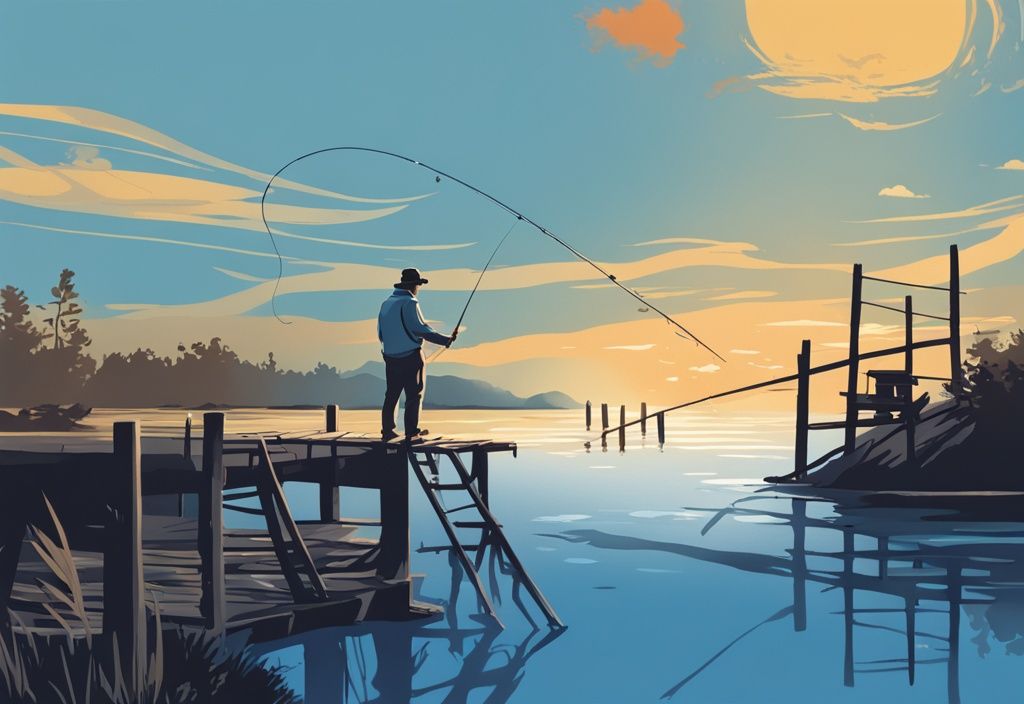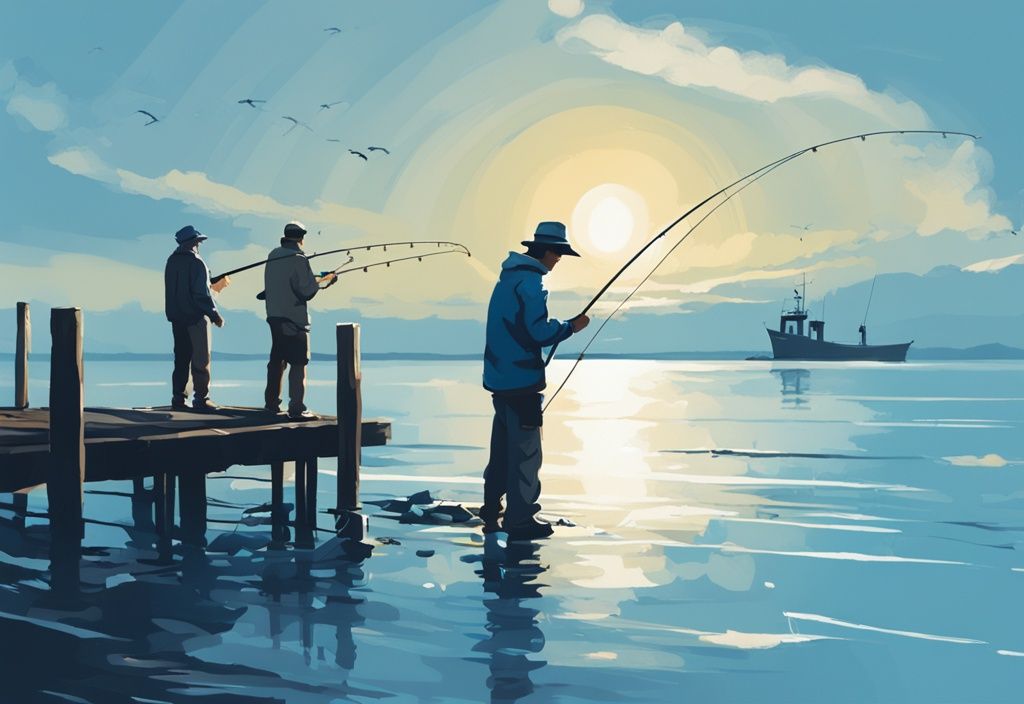Ever dreamt of reeling in a giant snapper without leaving solid ground? Welcome to the universe of jetty fishing! As a passionate angler with over 20 years of experience, let me tell you, there’s no thrill quite like it.
Not only a boat-free gateway into saltwater fishing, jetty fishing brings you face-to-face with a multitude of marine species. The structures–made of concrete and stone–create an underwater nirvana where fish freely congregate. And the best part? It’s an experience tailored to all abilities, even those of us still grappling with casting the line.
In this guide, you’ll uncover the secrets of jetty fishing that I’ve amassed over the years – from the right gear to techniques that yield a fruitful catch. Let’s get you hooked!
Why Choose Jetty Fishing
Jetty fishing captivates anglers both new and experienced due to its accessibility, diverse catches, and family-friendly opportunities. It offers a unique blend of ease and excitement that makes it a popular choice among fishing enthusiasts.
The Appeal and Benefits of Jetty Fishing
Jetty fishing, an increasingly popular facet of angling, provides a unique and favorable environment for fish. The currents and abundance of bait around the jetty structure create an ecosystem teeming with marine life. The base of a jetty intercepts water currents, forming a suitable habitat for various fish species. These environments attract fish seeking food and shelter, significantly enhancing the fishing experience.
The robustness of jetties extends their benefits beyond mere physical structures. Jetties gather vegetation, mollusks, crabs, and small baitfish, becoming food sources for larger predatory fish. This natural congregation of marine life makes jetty fishing a hotspot for anglers looking to catch a range of substantial fish species without venturing into deeper waters.
Jetties accumulate vegetation, mollusks, crabs, and small baitfish, which serve as food sources for larger predatory fish. This natural aggregation makes jetty fishing a prime spot for catching varied and sizable fish species—without needing to venture far offshore. Imagine casting your line and feeling that thrilling tug from a hefty fish, all within the comfort of a jetty.
Accessibility and Popularity
One of the core advantages of jetty fishing is its accessibility. No boat? No problem! Simply stroll onto the jetty, and you’re at a productive fishing spot. This convenience makes jetty fishing perfect for spontaneous trips and for those who don’t own or prefer not to use a boat.
Jetty fishing is not just accessible; it’s family-friendly and serves as an excellent introduction to fishing for children and beginners. The safe, controlled environment allows novice anglers to build confidence and hone their skills. Families can bond over a shared love of the sport while learning about marine life and fishing techniques.
Jetty fishing also attracts anglers of all skill levels. Beginners appreciate the easy access to fruitful fishing grounds, while seasoned pros relish the diverse and challenging opportunities jetties offer. This broad appeal contributes significantly to jetty fishing’s popularity.
By providing easy access, a safe environment, and a variety of fishing opportunities, jetty fishing shines as a compelling choice for anglers of all ages and skill levels. Its blend of accessibility, family-friendliness, and potential for diverse catches underscores why jetty fishing remains a cherished part of the angling community.
So next time you’re considering a fishing trip, why not give jetty fishing a try? Whether you’re a rookie or a veteran, the jetty offers an unmatched, enriching experience.
Structures and Environments: Understanding Jetties
What Makes Up a Jetty: The Basics
Jetties are essential marine structures constructed primarily from durable materials such as concrete and stone. These robust materials ensure that jetties can withstand the constant battering of waves and the harsh conditions of saltwater environments. Extending into the water, jetties serve several purposes, including breaking up water flow and reducing shoreline erosion, which helps protect coastal areas from damage.
Moreover, jetties are designed to foster diverse ecological systems. Over time, they accumulate vegetation, create habitats for mollusks and crabs, and provide a rich environment for both baitfish and game fish. This accumulation of marine life makes jetties highly attractive spots for anglers, as they offer a concentrated area where fish are abundant.
Environmental Impact: The Benefits of Jetties
Jetties play a vital role in creating beneficial microenvironments that support various marine life forms. Acting as artificial reefs, they attract a wide array of fish species by providing shelter and a stable food source. The structure of a jetty, with its crevices and overhangs, offers protection and feeding opportunities for smaller organisms, which in turn attract larger predator fish.
The ecological benefits of jetties extend beyond just attracting fish. They help maintain the balance of marine ecosystems by supporting the life cycle of many aquatic species. For example, smaller fish and baitfish find refuge in the nooks of the jetty, which helps sustain their populations and provide a consistent food source for larger game fish.

What Makes Jetties Attractive to Fish
Jetty fishing, also known as pier or breakwater fishing, is a cherished method for many anglers. Jetties create unique ecosystems that attract a diverse range of fish species, making them a hotspot for fishing adventures.
The Variety of Fish Attracted to Jetties
Jetty fishing isn’t just about the sport; it’s about the thrill of encountering a broad spectrum of fish. Picture this: you’re standing on a jetty, the sun warming your back, when suddenly, your line tightens as a tarpon seizes your bait. It’s this variety that brings fish like striped bass, redfish, and bluefish to these rocky outcrops. The currents around jetties deliver a constant supply of food, turning them into prime hunting grounds. The easy availability of prey makes jetty fishing so irresistible for larger, more aggressive fish, which is why it’s a beloved choice for many seasoned anglers.
Impact of Water Currents in Jetty Fishing
Understanding the dance of water currents around jetties is the key to mastering jetty fishing. Jetties often experience varying currents, which play a crucial role in where bait and fish gather. Take the up-current side, for example—this spot tends to collect more bait and nutrients. Why? Because the currents push organic material and smaller fish right up to the jetty, creating a buffet for predatory fish. You’ll often find them lurking near the rocks, where the food is abundant and easy to reach.
In summary, the strategic placement of jetties disrupts water flow to create ideal feeding conditions for a variety of fish species. Combine this with easy access to prey and the influence of water currents, and you’ve got a perfect spot for both novice and seasoned anglers practicing jetty fishing.
So next time you’re planning a fishing trip, consider the jetty. With a bit of knowledge and a lot of enthusiasm, you’ll find it’s one of the most rewarding and exciting ways to fish. Happy fishing, and may your lines always be tight!
The Art of Jetty Fishing: Techniques and Methods
Traditional Bottom Fishing: A Step-by-Step Guide
Traditional bottom fishing is a cornerstone technique in jetty fishing, perfect for targeting species that hang out near the sea floor. This method involves placing bait right on or just above the ocean bed. We’re talking about ground fish like snapper, grouper, and halibut—real prize catches. The typical setup includes a weighted sinker at the end of your line, followed by a sturdy leader and a baited hook. The weight keeps the bait in the sweet spot, while the leader makes sure the fish don’t sense the resistance from your rod.
Successful bottom fishing demands patience and the right bait. But don’t get discouraged; it’s an accessible method for anglers of all skill levels who want to get a feel for what is jetty fishing. Picture yourself waiting quietly, feeling the rhythmic pull of the ocean. It’s a serene, almost meditative experience, and when you finally get that bite? Pure exhilaration.
The Ropes of Drift Fishing
Drift fishing brings a bit more action to the table and is perfect for jetty fishing. This technique uses a bobber or popping cork to keep your bait suspended at various depths. Depending on what you’re after, you can target species at different levels of the water column. As your line drifts naturally with the current, the bait looks alive and inviting to fish.
Adjusting depth is key here. You need to be spot-on with your target species and the water conditions. Think of it as reading the ocean’s mood. With the right setup and a knack for sensing water currents, drift fishing can be incredibly satisfying. It’s a dynamic way to deepen your understanding of what is jetty fishing. Have you ever felt the thrill of a bobber diving under the surface? That’s the kind of excitement drift fishing offers.
Using Live and Artificial Bait
The debate between live and artificial bait is like an age-old fish tale—everyone has their favorite, and both have their perks. For jetty fishing, live baits like shrimp, squid, and minnows are hard to beat. They exude natural scents and movements that predatory fish find irresistible. Imagine casting a live shrimp and watching it dance just beneath the surface, waiting for that telltale strike.
But don’t count out artificial baits. Lures, jigs, and soft plastics offer versatility and ease of use. Available in various designs and colors, they mimic the appearance and movement of real prey. Whether you opt for the genuine article or a clever imitation, understanding your bait is crucial for mastering what is jetty fishing. Isn’t it fascinating how a well-chosen lure can mimic life so convincingly?
Trolling Around Jetties
Trolling takes jetty fishing to another level of excitement. It involves slowly pulling a spread of lures or baited lines behind a moving boat, close to the jetty. This method targets fish in open water areas right next to the structure. It’s perfect for species that are on the hunt, like bluefish and striped bass.
The idea here is to simulate fleeing prey, making those predatory fish go absolutely wild. Maintaining a steady speed and keeping a close eye on your lines for bites is crucial. For those eager to delve deeper into what is jetty fishing, trolling offers a proactive and exhilarating experience. Picture the thrill of your rod bending under the weight of a tenacious fish—it’s an angling adventure like no other.

Essential Kit: Jetty Fishing Equipment and Gear
Must-Have Gear for Jetty Fishing
Proper equipment is crucial for a successful jetty fishing adventure. When delving into what is jetty fishing, understanding the essential gear is fundamental. Saltwater fishing rods and terminal tackle form the backbone of your setup. These rods, generally constructed from graphite or fiberglass, can range in weight from 2-4kg for lighter catches to heavier configurations suited for larger game fish. The reel is another key component, with sizes typically ranging from 1000-2500 series, ensuring durability and optimal performance in saltwater conditions.
Tackle Box Essentials
A well-stocked tackle box is indispensable for jetty fishing enthusiasts. Hooks of various sizes, sinkers to anchor bait, and swivels for connecting lines should be staples. Leader material is essential, particularly when targeting larger fish with sharp teeth that can easily cut through regular fishing lines. Additionally, tools such as long-nose pliers for hook removal, braid scissors for cutting lines, and fishing grips for handling catches make your fishing experience more efficient and enjoyable. These items collectively enhance your understanding of what is jetty fishing and prepare you for various scenarios.
Safety First: Gear and Precautions to Remember
Safety is paramount when fishing from jetties due to the unique challenges this environment presents. Sturdy, non-slip footwear provides grip on potentially slippery surfaces, preventing accidents caused by unstable footing. Lifejackets are mandatory, especially in areas with strong currents or for those who are not confident swimmers. Being acutely aware of the environment, such as wave patterns and sudden tidal changes, is crucial. By prioritizing safety, you create a secure and enjoyable jetty fishing experience, enriching your knowledge of what is jetty fishing and enabling you to fish confidently and responsibly.
Plan Your Jetty Fishing Adventure
Finding Your Jetty: Top Locations
When planning a jetty fishing adventure, location is key to a successful outing. One of the top spots is the Long Beach Breakwater, a nine-mile stretch renowned for its productive fishing conditions. It’s crucial to research local jetties, as many are known for their unique fish populations and favorable conditions.
Explore online forums, fishing guides, and local fishing reports to identify jetties that promise a rewarding experience. Each jetty offers different environments, so understanding their characteristics will help you make an informed choice.
The Best Times to Go Jetty Fishing
Timing your fishing trip can significantly enhance your success. The peak times for jetty fishing are typically during high tide or at the beginning of a falling tide. These periods bring more fish close to the jetty as they search for food.
Early morning and late evening are also prime times, as fish tend to be more active during these cooler parts of the day. Observing tidal charts and local fishing forecasts can help you plan the optimal time for your adventure, increasing your chances of a fruitful catch.
Jetty Fishing: A Fun Family Activity
Jetty fishing isn’t just for hardcore anglers; it’s a fantastic way to introduce children and families to the joys of fishing. The easy access to the water and the opportunity to catch a variety of fish make it an ideal family outing.
Jetty fishing trips can be tailored to suit different preferences and schedules, ranging from half-day excursions to full-day adventures. This flexibility allows families to enjoy the experience without the need for extensive planning or specialized equipment.
By engaging in jetty fishing, families can bond, learn new skills, and create lasting memories together.
Jetty Fishing Techniques for Different Fish Species
To reel in a variety of fish from the jetty, you need tailored strategies for different species. This section breaks down the techniques for both larger and smaller fish, ensuring you have a comprehensive approach to jetty fishing.
Tailored Strategies for Larger Fish
Ever tried your luck with giants like tarpon and striped bass? The thrill is unmatched! When targeting these larger species, bottom fishing and trolling are your go-tos. Picture this: you’re standing on the jetty, casting your line with bait nestled close to the sea floor. That’s bottom fishing – ideal for snagging hefty, bottom-dwelling fish.
Make sure you’ve got a sturdy rod setup with a weight, leader, and a well-baited hook. Trust me, you’ll thank yourself later. Now, if you’re the adventurous type, trolling can be a game changer. This technique, where you pull a spread of lures or live bait behind a boat or along the jetty, lures in active predators in the open water areas nearby. And hey, don’t skimp on the heavy tackle and live bait – it’s crucial for success in both methods.
Tips for Fishing Smaller, Plentiful Species
If you’re looking to pocket smaller dames like Bream and Whiting, finesse is key. Lighter tackle and smooth techniques will be your allies here. Imagine letting your bait drift naturally with the current – that’s drift fishing, and it’s highly effective for these delicate fish.
You also can’t go wrong with small lures mimicking the natural prey of these fish. Live bait like shrimp or minnows? Absolute game-changers. With light rods and reels, you’ll feel even the tiniest nibbles, boosting your chances of a fruitful catch.
In either scenario, understanding what is jetty fishing – leveraging the unique structure and current patterns of jetties – is pivotal. Jetties create a haven by disrupting water flow and sheltering bait and gamefish, making them prime hotspots for your diverse fishing tactics. Get ready to maximize your day at the jetty with these techniques tailored to your target species.

Prioritizing Safety When Jetty Fishing
Jetty fishing is an exhilarating pursuit that brings anglers closer to the raw, untamed beauty of the sea. From the gentle lap of waves against the rocks to the suspense of a tug on the line, every moment on the jetty is filled with excitement. Yet, the allure of jetty fishing comes with its own set of challenges and potential hazards that every angler should be mindful of.
Dangers to Watch Out for in Jetty Fishing
Imagine standing on a jetty as the sun rises, casting a golden hue over the water. But beneath this serene surface lie some real dangers that can turn your fishing trip into a story best untold. One of the most critical dangers is **slippery surfaces**; jetties often become wet with algae or moss, making them slick as ice. Ever experienced that embarrassing slip? Exactly. To stay on two feet, sturdy footwear with a strong grip is your best friend.
Then there are those **sudden waves**. One moment you’re reeling in a catch, the next you’re scrambling to keep your balance as a rogue wave crashes in from a passing boat or an unexpected tidal change. Keeping an eye on the water’s behavior, predicting those sneaky waves, can save you from a good soaking—or worse.
Ah, and let’s not forget the marine life. Watch out for **Stonefish and Toad Fish** hiding stealthily among the rocks. These little critters might blend in well, but a venomous sting from one will make you wish you’d been more careful. Always be cautious while moving around and handling anything you pull from the water.
Practicing Good Jetty Fishing Etiquette
Just as important as safety, is the etiquette that keeps our fishing spots pristine and enjoyable for everyone. Think of it as the unwritten code of respect among anglers. First off, **cleaning up and disposing of rubbish responsibly** is non-negotiable. Litter can mar the beauty of our fishing spots and harm wildlife. So, always pack a trash bag—leave nothing but footprints.
Next, let’s talk **local fishing regulations**. These aren’t just red tape; they’re essential guidelines to keep fish populations healthy. Ever caught a fish that’s too small only to release it back, knowing you’re doing your bit for future generations? Exactly. Before heading out, brush up on the local rules—it’s part of being a responsible angler.
Understanding what is jetty fishing from a safety and etiquette perspective amplifies the joy and respect we have for nature and fellow anglers. With these principles, we ensure a positive and safe environment for all of us who share this passion.
Frequently Asked Questions About Jetty Fishing
Jetty fishing offers an exciting way to connect with nature and catch a variety of fish. Below, let’s dive into some common questions anglers often have about this rewarding activity. From bait tips to safety, you’ll find valuable insights to make your next jetty fishing trip a success.
What’s the recommended bait for jetty fishing?
When it comes to choosing bait for jetty fishing, it’s like setting up an irresistible buffet for your finned friends. Shrimp, squid, and minnows top the list. Think of live bait like smaller fish – they’re like the VIPs of the bait world, drawing in the big catch. Cut bait and artificial lures also work wonders, inviting a smorgasbord of species to your line.
How does the tide affect my jetty fishing success?
The dance of the tides can make or break your fishing day. High tide or the beginning of a falling tide usually offers the best chances. Fish are more active, scouring for food as the water rises. On the flip side, low tide can leave you with a more subdued, less lively fishing experience. Timing is everything!
I’m a novice, is jetty fishing a good starting point?
Absolutely, jetty fishing is a splendid starting point for beginners. It’s easy to access and offers a wide range of opportunities, welcoming all skill levels. Whether it’s your first bite or you’re honing your technique, jetty fishing is a fantastic way to dive into the sport and reel in the joy of the catch.
What safety measures are necessary when jetty fishing?
Safety first! Wear sturdy, non-slip footwear to navigate those slick rocks. A lifejacket is essential, especially when the waves get a bit frisky. Always keep an eye on the tides – they can sneak up on you. And of course, be mindful of slippery surfaces to keep those missteps at bay. Staying safe ensures you’ll be back for more thrilling fishing adventures.
Are there specific legal considerations for jetty fishing?
Indeed, following the rules is crucial. Always check that you have the right fishing licenses and adhere to the local regulations. This includes respecting allowable catches, size limits, and seasonal restrictions. Fishing legally and sustainably keeps the environment thriving and ensures the sport remains enjoyable for everyone.


